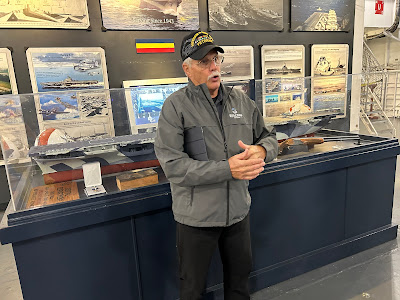Viewing the U.S.S Yorktown from the Cooper River bridge as you pass by in a car doesn't do it any justice. Stand on the pier just below its gaping entrance, and you experience the full scope of its massiveness. However, scale the broad, steel steps and enter its interior, and you will feel like you were just swallowed by a gigantic iron whale. Numerous antique aircraft spanned the total length of the main deck to the right, and to the left, a museum with a restored B-25B Mitchell medium bomber used in the Doolittle Raid on Tokyo just beyond.
We had reserved the Captain's Tour: Steel Canva offered by Bulldog Tours. We checked in at the Information Booth and waited for our guide. There would end up being six people altogether in our group--a very manageable number. Upon arrival, the guide introduced himself and stated his credentials, along with a few humorous statements bunched in to lighten things up. A retired Navy man, Tom Simons had served on several ships as an aviation mechanic. His gentlemanly and personable demeanor was accentuated by a striking military stature.
He led us to a replica of the U.S.S Yorktown housed in a glass case, where he began a detailed history of the ship from its beginnings to its decommission and finally ended up stuck in the mud of Charleston's Cooper River to serve as a Naval and Maritime Museum. He also talked about the ship's first captain, Joseph James "Jocko" Clark--the first Native American to serve in that capacity.
Next, he made a brief stop to highlight a museum dedicated to Medal of Honor recipients and their stories--not a part of the tour but could be viewed anytime before or after. We took a short walk from the museum to the restored B-25 bomber used in the Doolittle Raid, where pictures of the 16 crews that partook in the raid and their stories lined an adjacent wall. We were afforded the opportunity to step aboard the display's bomber called the Ruptured Duck--a unique feature of this tour.We now descended into the ship's guts to the crew's quarters, torpedo arming area, the galley, food preparation, dental offices, and medical quarters. A highlight was a stop at a drinking fountain, where the guide detailed the story that gave birth to the word "scuttlebutt."
We left the lower decks and trekked across the main deck to ascend several flights of steps at the very front of the ship to where the ship's huge anchor was stored, called the fo'c'sle or anchor room--each link of the long chain weighed 130 pounds with color coding positioned at various points of its length. From the anchor room, our group entered the upscale Captain's Quarter. Pictures of celebrity Ann Margaret, who once stayed on the Yorktown, hung on the wall. From there, we moved to the command centers and the flight deck, which was the end of the tour.
The tour was a total success, and that was because of our tour guide. He made it entertaining and enthralling. He spoke to each of us personally even though we were a group of six. His narrations were a balanced blend of facts and humor. As to the ship, it speaks for itself in many ways as you get an eyewitness look at its splendor and a glimpse into what it was like to live and serve on its decks. You get access to some things self-guided patrons do not on this tour. It is two hours long.
Photographs contributed by Anne-Merle Bryant
Adults: $42
Child (4-12): $29
Senior: $34
Military: $36
3 and under free
Bulldog Tours, 18 Anson Street, Charleston, SC













Very informative and interesting account! Thank you
ReplyDelete